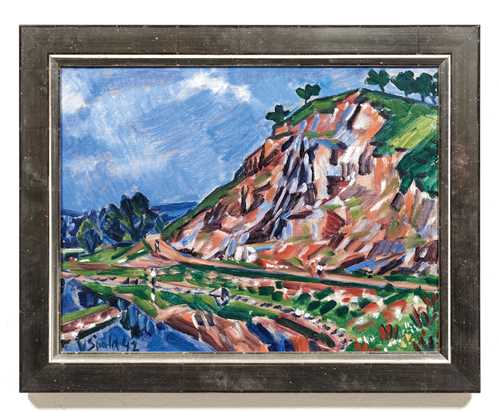
Lot 3516 - A193 Impressionist & Modern Art - Friday, 03. July 2020, 04.00 PM
VÁCLAV ŠPÁLA
(Zlunice 1885–1946 Prague)
Skála a řeka (rock and river). 1942.
Oil on canvas.
Signed and dated lower left: VSpala 42. On the reverse on the stretcher with the inventory number: (1523).
38.5 × 50.5 cm.
The work is listed in the catalogue raisonné of the artist under number 1523.
Provenance:
Swiss private collection.
The Czech-born painter and illustrator Vaclav Špála is one of the most important artists of the Czech avant-garde. Špála studied at the Academy of Fine Arts in Prague and in 1905 visited the stimulating exhibition of Edvard Munch in the Manes Gallery. The gallery additionally showed paintings by the Fauvists and the Cubists, which had a strong influence on Špála's work. In 1911 he became a co-founder of the Group of Fine Artists and in 1918 the artist group Tvrdošíjní (The Stubborn Ones).
Špála painted in his typical style from 1920 onwards. At first influenced by the Fauvists, his late work is strongly informed by Cubism. Simply contoured spaces are rendered in broad strokes of colour. Also very distinctive is the selection of colours — reduced almost exclusively to blue, red and white. After 1923 Špála mainly focused on still lifes and landscape painting. The work presented here is one of the artist's late works and shows a view of a river near Berounka and Otava with a striking cliff. This locality is depicted in several paintings by Špála from the 1930s onwards and must have been a favourite subject of his.
Vaclav Špála is one of the classics of Czech painting, without whom no collection of Czech Modernism would be complete and whose work has also taken its place in international discourse. As Prof. Matějček described Špála's work: “[…] the artist speaks to us through his canvases. His mature work, whose origin is regional and bears witness to the vital language of his people, has established itself within the international art world” (translated from German).
Provenance:
Swiss private collection.
The Czech-born painter and illustrator Vaclav Špála is one of the most important artists of the Czech avant-garde. Špála studied at the Academy of Fine Arts in Prague and in 1905 visited the stimulating exhibition of Edvard Munch in the Manes Gallery. The gallery additionally showed paintings by the Fauvists and the Cubists, which had a strong influence on Špála's work. In 1911 he became a co-founder of the Group of Fine Artists and in 1918 the artist group Tvrdošíjní (The Stubborn Ones).
Špála painted in his typical style from 1920 onwards. At first influenced by the Fauvists, his late work is strongly informed by Cubism. Simply contoured spaces are rendered in broad strokes of colour. Also very distinctive is the selection of colours — reduced almost exclusively to blue, red and white. After 1923 Špála mainly focused on still lifes and landscape painting. The work presented here is one of the artist's late works and shows a view of a river near Berounka and Otava with a striking cliff. This locality is depicted in several paintings by Špála from the 1930s onwards and must have been a favourite subject of his.
Vaclav Špála is one of the classics of Czech painting, without whom no collection of Czech Modernism would be complete and whose work has also taken its place in international discourse. As Prof. Matějček described Špála's work: “[…] the artist speaks to us through his canvases. His mature work, whose origin is regional and bears witness to the vital language of his people, has established itself within the international art world” (translated from German).
CHF 30 000 / 50 000 | (€ 30 930 / 51 550)
Sold for CHF 71 060 (including buyer’s premium)
All information is subject to change.


